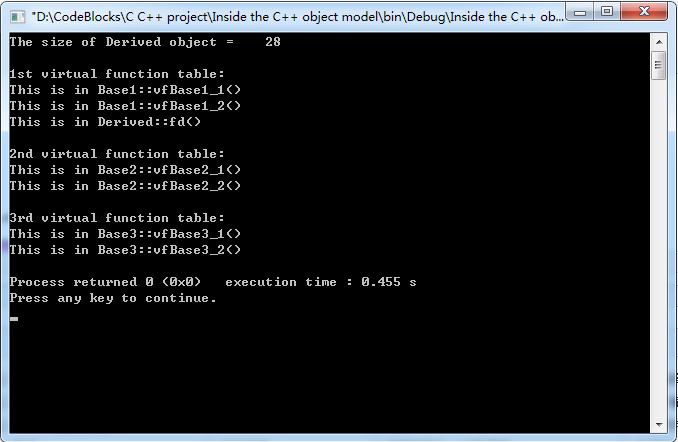内容概要:
满足下面3个条件时,
1. 父类有虚函数,子类也有虚函数,且子类的虚函数重写或覆盖了父类的虚函数
2. 非虚继承
3. 多重继承
类对象之内存布局
多重继承,派生类不重写基类中的虚函数。
假定各类之间的关系如下图:

代码如下:
#include <iostream> using namespace std; class Base1 { public: int m_base1; inline virtual void vfBase1_1() { cout << "This is in Base1::vfBase1_1()" << endl; } inline virtual void vfBase1_2() { cout << "This is in Base1::vfBase1_2()" << endl; } }; class Base2 { public: int m_base2; inline virtual void vfBase2_1() { cout << "This is in Base2::vfBase2_1()" << endl; } inline virtual void vfBase2_2() { cout << "This is in Base2::vfBase2_2()" << endl; } }; class Base3 { public: int m_Base3; inline virtual void vfBase3_1() { cout << "This is in Base3::vfBase3_1()" << endl; } inline virtual void vfBase3_2() { cout << "This is in Base3::vfBase3_2()" << endl; } }; class Derived : public Base1, public Base2, public Base3 { public: int m_derived; inline virtual void fd() { cout << "This is in Derived::fd()" << endl; } }; typedef void (*VFun)(void); template<typename T> VFun virtualFunctionPointer(T* b, int i) { return (VFun)(*((int*)(*(int*)b) + i)); } int main(void) { Derived d; cout << "The size of Derived object = " << sizeof(Derived) << endl; cout << endl; cout << "1st virtual function table: " << endl; int i = 0; while(virtualFunctionPointer(&d, i)&&i<3) { VFun pVF = virtualFunctionPointer(&d, i++); pVF(); } cout << endl; cout << "2nd virtual function table: " << endl; i = 0; //以32字长的机器,找到下一个继承base class的vptr int* tmp = ((int*)&d)+ sizeof(Base1)/4; //虚函数表中的虚函数后面不为NULL?如果不加i的限制会出现段错误,不能结束循环 while(virtualFunctionPointer(tmp, i)&&i<2) { VFun pVF = virtualFunctionPointer(tmp, i++); pVF(); } cout << endl; cout << "3rd virtual function table: " << endl; i = 0; tmp = ((int*)&d) +(sizeof(Base1)+sizeof(Base2))/4; while(virtualFunctionPointer(tmp, i)&&i<2) { VFun pVF = virtualFunctionPointer(tmp, i++); pVF(); } return 0; }
运行结果:

Derived对象之memory layout如下:

由上面的分析可知:
其一:有三个虚函数表
其二:在Derived类中定义的虚函数Derived::vfDerived()附加在一个虚函数表的最后
(注意:多重继承有多个虚函数表)